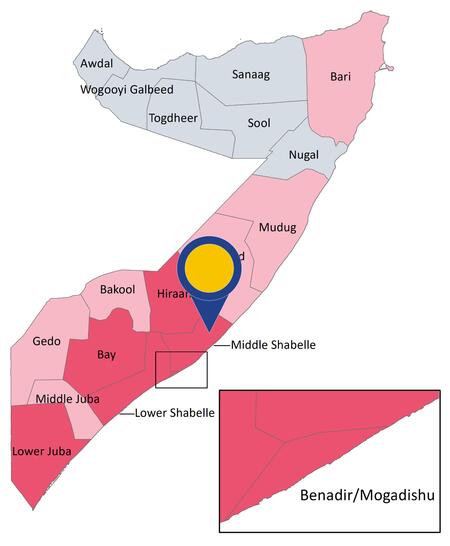COMMON ANALYSIS
Last updated: June 2022
The situation in Middle Shabelle should be seen in light of the situation in the neighbouring regions of Benadir/Mogadishu, Lower Shabelle, and Hiraan.

General information about the region
Middle Shabelle region is located in the south-east of Somalia and consists of four districts. The region’s capital is Jowhar.
Middle Shabelle is mainly inhabited by Hawiye sub-clans, the dominant clan being the Abgaal. Other clans/groups present in the area are the Gaaljeel, the Bantu Shiidle, and other minority clans.
In 2014, UNFPA and Somali authorities estimated the population of Middle Shabelle region at 516 036 inhabitants.
Background and actors involved in armed confrontations
Besides the clans and Al-Shabaab, another important actor in the region is the SNA. Like in many other regions in Somalia, Al-Shabaab controls the rural areas whereas the major towns are controlled by state and federal forces, with the help of AMISOM. Al-Shabaab, was involved in 69% of the incidents in Middle Shabelle between 1 January 2020 and 30 June 2021.
The proximity to Mogadishu makes Middle Shabelle a satellite of Mogadishu’s local administration and of the Hawiye dominant position there. In particular, the Abgaal clan group, which is dominant in Middle Shabelle, and is also dominant in Mogadishu, makes no distinction between the two administrations. A number of intra-clan conflicts have been reported.
The other major source of conflict in the region was the presence and the activities carried out by Al-Shabaab.
Nature of violence
The majority of the incidents involving Al-Shabaab also involved Somali Armed Forces or Somali Police Force, AMISOM forces and civilians. The main type of Al-Shabaab-related incidents were armed clashes along with the use of remote-controlled explosives and attacks against civilians. The group mostly carried out hit-and-run attacks targeting Somali Security Forces and AMISOM.
In July 2021, Al-Shabaab fighters set residential areas on fire in War-Dhagah, Gallef locality and abducted people with suspected links with government security forces.
Other illustrative security incidents include the clashes between SNA forces and Al-Shabaab on 29 May 2021 in Xaararay village near Jowhar town killing 37 militants and injuring 40 others.
On 27 May 2020, seven Somali health workers were kidnapped in Middle Shabelle region and killed. The kidnapping of an eighth health worker on the same day was also reported.
On 14 April 2021, a minibus travelling from Mogadishu to Jowhar struck an IED near Balcad town. Up to 17 people were reportedly killed.
Violent incidents against civilians related to clan conflicts over land included the killing of five teachers by Al-Shabaab at a Quranic school in Cadale district in September 2020.
Among others, security incidents related to clan conflicts do not always receive local media attention and hence might go under-reported in Somalia.
Incidents data
ACLED recorded 285 security incidents (an average of 3.7 security incidents per week) in Middle Shabelle region between 1 January 2020 and 30 June 2021. Out of those incidents, 146 were coded as battles, 88 as explosions/remote violence and 51 as violence against civilians.
Geographical scope
Security incidents occurred in all 4 districts of Middle Shabelle with the largest overall number being recorded in Jowhar district (148 events), followed by Balcad District (108 events) for the period between January 2020 and end of June 2021.
Fatalities among civilians and non-civilians
In the reference period, ACLED recorded a total of 575 fatalities in the region. Compared to the figures for the population in the region as from 2014, this represents approximately 111 fatalities per 100 000 inhabitants.
Displacement
Between January 2020 and May 2021, PRMN reported an estimated 297 000 new displacements from Middle Shabelle, the vast majority of them within the region. In 2020, flooding and drought were the reasons behind the vast majority of diplacements. In 2021, conflict and insecurity were the reason for displacement for 8 000 persons.
Further impact of the armed conflict(s) on the life of civilians
Clan violence affected people’s lives and livelihoods as well as caused displacements in Middle Shabelle. Clan conflicts were also the reason that humanitarian programmes were suspended. Al-Shabaab has also disrupted major supply routes in areas not directly under its control. For instance, FGS and Hirshabelle officials can no longer travel by road between Mogadishu and Jowar, having to fly instead.
|
|
Looking at the indicators, it can be concluded that ‘mere presence’ in the area would not be sufficient to establish a real risk of serious harm under Article 15(c) QD in the region of Middle Shabelle. However, indiscriminate violence reaches a high level, and, accordingly, a lower level of individual elements is required to show substantial grounds for believing that a civilian, returned to the territory, would face a real risk of serious harm within the meaning of Article 15(c) QD. |
